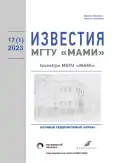Calculation method for determining the heat loss of the air environment when opening the passenger vehicle cabin doors
- 作者: Gevorkyan A.V.1,2, Prokhorov I.V.1,2, Butarovich D.O.1,2
-
隶属关系:
- Bauman Moscow State Technical University
- Lipgart Engineering Center of GAZ Group
- 期: 卷 17, 编号 1 (2023)
- 页面: 51-61
- 栏目: Transport and transport-technological complexes
- URL: https://bakhtiniada.ru/2074-0530/article/view/131456
- DOI: https://doi.org/10.17816/2074-0530-321203
- ID: 131456
如何引用文章
全文:
详细
BACKGROUND: The microclimate in the bus cabin is of great importance in terms of both safety and comfort. The main parameters of the microclimate are temperature, humidity, dustiness and gassiness of the air, air exchange, the temperature of the elements of the interior surfaces and thermal radiation.
AIMS: The article presents the results of calculating the heat loss in the air environment of the bus cabin using a mathematical model and experimental method.
METHODS: The influence of different features of vehicle interior and exterior topology on the heat losses through the doors was estimated. The estimation of heat losses was performed using the ANSYS Fluent software package. The final result is to obtain the heat loss characteristics as a time-domain function. A field experiment was carried out to verify the obtained results.
RESULTS: A set of numerical values and graphic characteristics giving an idea of the heat losses through the open doors of the bus cabin are presented.
CONCLUSIONS: Due to the developed calculation method of determining the heat losses of the air environment, numerical values and graphical characteristics of the amount and intensity of time-dependent heat losses were obtained. The obtained results were verified experimentally. The study showed that the simulation in ANSYS Fluent and the field experiment have a discrepancy due to high values of the time constant of temperature sensors. In order to obtain the most accurate results, it is necessary to carry out the experiment with a time interval greater than the time constant.
作者简介
Artem Gevorkyan
Bauman Moscow State Technical University; Lipgart Engineering Center of GAZ Group
编辑信件的主要联系方式.
Email: gevorkyan-99@inbox.ru
ORCID iD: 0000-0002-9872-7931
Student of the Wheeled Vehicles Department, Laboratory Assistant
俄罗斯联邦, Moscow; MoscowIvan Prokhorov
Bauman Moscow State Technical University; Lipgart Engineering Center of GAZ Group
Email: prokhoroviv@yandex.ru
ORCID iD: 0000-0001-8843-4468
SPIN 代码: 8611-4198
Senior Lecturer of the Wheeled Vehicles Department, Technician
俄罗斯联邦, Moscow; MoscowDmitry Butarovich
Bauman Moscow State Technical University; Lipgart Engineering Center of GAZ Group
Email: buta73@bmstu.ru
ORCID iD: 0000-0003-4539-0463
SPIN 代码: 2250-1713
Cand. Sci. (Tech.), Associate Professor of the Wheeled Vehicles Department, Chief Executive Officer
俄罗斯联邦, Moscow; Moscow参考
- Maxwell P, Durrani F, Eftekhari M. Investigating Heat Loss through Vestibule Doors for a Non-Residential Building. Sustainability in Environment. 2016;1(1):26–29. doi: 10.22158/se.v1n1p25
- Aksoy MH, Yagmur S, Dogan S. CFD modelling of industrial air curtains with heating unit. EPJ Web of Conferences. 2019;213(5):2–5. doi: 10.1051/epjconf/201921302001
- Qi D, Goubran S, Wang L(L), Zmeureanu R. Parametric study of air curtain door aerodynamics performance based on experiments and numerical simulations. Building and Environment. 2018;129:65–73. doi: 10.1016/j.buildenv.2017.12.005
- Kharitonov V.P. Fundamental equations of fluid and gas mechanics. Moscow: MGTU im NE Bauman; 2012. (in Russ).
- Bukhmirov V.V. Heat and Mass Exchange: Textbook. Ivanovo: FGBOUVPO «Ivanovskiy gosudarstvennyy energeticheskiy universitet imeni V.I. Lenina»; 2014. (in Russ).
- Korkodinov YA. The review of set of k–ε models for modeling turbulence. Bulletin PNRPU. Mechanical engineering, materials science, 2013;2:5–16. (in Russ).
- Sosnowski M, Krzywanski J, Grabowska K, et al. Polyhedral meshing as an innovative approach to computational domain discretization of a cyclone in a fluidized bed CLC unit. EPJ Web of Conferences. 2017;14(2). doi: 10.1051/ 71401027
- Sosnowski M, Krzywanski J, Grabowska K, et al. Polyhedral meshing in numerical analysis of conjugate heat transfer. EPJ Web of Conferences. 2018;180(6). doi: 10.1051/epjconf/201818002096
- Razina AP. Thermal inertia of temperature sensors. Otraslevoy nauchno-tekhnicheskiy zhurnal «ISUP». 2020;2(86). (in Russ). Accessed: 31.10.2022. Available from: https://isup.ru/articles/16/15436/
补充文件




















